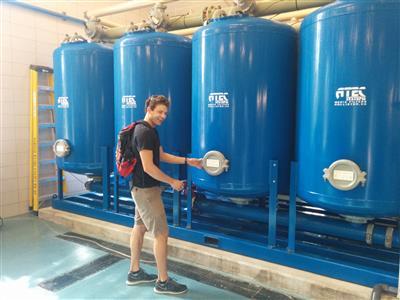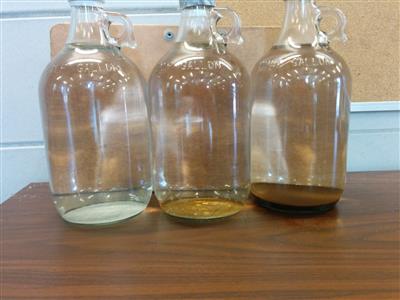
Credit: Matthew Ginder-Vogel
January 23, 2015
By Marie Zhuikov
If you’ve ever turned on the tap only to have rusty or gray water gush out, you can sympathize with what residents of Madison, Wis., experienced in 2005. Routine flushing of city water mains caused discolored water, which tasted strange and stained laundry in homes and businesses.
The culprits? Dissolved manganese and iron. In a quest to access the safer drinking water in deeper aquifers, the city drilled into water rich in these two elements. When the water mains were flushed during warm months to remove sediment and minerals in the pipes, the action also pushed through gray-black dissolved manganese and rusty-red iron.
Although these elements are more a nuisance than a health hazard, two University of Wisconsin-Madison researchers are concentrating on manganese because, ironically, it might be useful in cleaning water, including removing bisphenol A. With funding from the University of Wisconsin Water Resources Institute, assistant professors Matthew Ginder-Vogel and Christina Remucal are looking at the source of manganese in the aquifer rocks and how the manganese that ends up dissolved in the water reacts with other compounds, especially pollutants.
“Madison has set up filters to remove manganese from the water,” said Ginder-Vogel. “This generates reactive solids that could be used in beneficial ways. Right now, the solids are sent through the sanitary sewer system or disposed of as solid waste. We had the idea of looking at whether the manganese collected on the filters can be beneficially reused down the line, perhaps for stormwater treatment.”

Credit: Matthew Ginder-Vogel
Madison does not get its drinking water from the iconic lakes Mendota or Monona, but from groundwater more than 320 feet down in the Mt. Simon Aquifer. This aquifer lies beneath many communities in Iowa, southeastern Minnesota, Wisconsin and the Upper Peninsula of Michigan. In the Madison area, the rocks that compose the aquifer contain manganese.
Manganese is natural and occurs in air, soil and water. Although it is an essential nutrient at low doses, long-term exposure to high doses can harm the nervous system of people and animals, potentially causing tremors, lethargy and mental disturbances.
After the discoloration episodes in 2005, four out of 24 wells in Madison were found to produce water that exceeded recommended levels of manganese. In response, the city installed filters and employed a different method of flushing problematic water mains, called “unidirectional flushing,” which minimizes the water discoloration reaching homes and business.
The researchers and their two graduate students are six months into their two-year project. They spent time at manganese-rich city well 29 in eastern Madison, collecting
manganese solids from its filters. They also followed water utility workers around in a van full of five-gallon buckets and collected solids from their water main flushing activities, Ginder-Vogel said.
Remucal said results look promising. “We’ve found that the manganese solids are capable of degrading organic pollutants. We’ve been working on bisphenol A, a contaminant that’s found in plastic.”
The U.S. Department of Health and Human Services has “some concern” for bisphenol A’s effects on the brain, behavior and prostate gland in fetuses, infants and children at current exposure levels. Also of concern is the chemical’s ability to induce earlier puberty in children.
For Remucal and Ginder-Vogel, the project is one made in academic heaven. “Christina is a specialist in organic contaminant transformation and has done some minerals surface work. I’m a specialist in mineral surface chemistry. It just seemed like a great way to collaborate on an interesting and applicable problem,” Ginder-Vogel said.
The two hope their project will provide guidance to regulators and water quality managers on the sources and reactivity of manganese in the Madison water distribution system. It could also provide information for other water utilities that face elevated manganese. And it just may be a great way to turn a water nuisance into a water cleanser.



